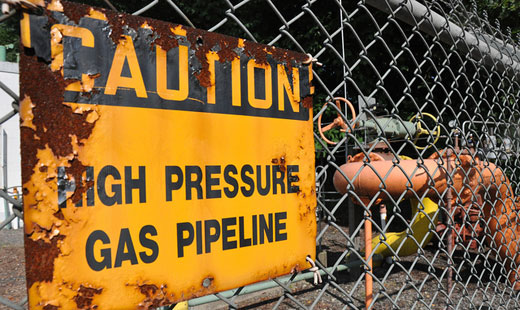
President Obama made history on June 25, 2013, when he announced his national climate action plan, the most bold and comprehensive environmental agenda proposed by a president. The plan would address harmful greenhouse gas emissions that contribute to climate change. On Mar. 28 this year, the president added a new layer to that plan: a strategy to cut methane emissions. And that means stricter oversight on the oil, coal, and gas industries.
The new strategy aims to reduce the output of methane, which reportedly has 20 times the effect on global warming that other gases, like carbon dioxide, have. As part of that, the EPA will propose updated standards this summer to curb methane released from landfills. Meanwhile, the Interior Department’s Bureau of Land Management will propose plans to capture and dispose of methane used in coal mines. And in June, the U.S. Department of Agriculture, EPA, and Department of Energy will partner with the dairy industry to reduce its methane emissions by 25 percent by 2020. Finally, the EPA will also begin soliciting input from independent experts on how to reduce methane released by the oil and gas industries, and will attempt to have stricter regulations imposed by 2016.
“Reducing methane emissions is a powerful way to take action on climate change,” said the White House in an official statement Mar. 28. “When fully implemented, the policies in the methane strategy will improve public health and safety.”
“When it comes to preventing the most serious impacts of climate change, we don’t have any time to waste,” said Earthjustice vice president of policy and legislation Marty Hayden. “This important announcement signals that the president is poised to take action on several fronts. The oil and gas industry has fought against limiting its harmful methane emissions. This industry needs to be held accountable for the reckless damage it is causing to our warming climate as well as the immediate harm it is causing to communities where it operates. We welcome strong action by the Obama administration to reduce methane emissions.”
Lauren Pagel, policy director of nonprofit environmental organization Earthworks, saw this as a marked change from how the Obama administration had previously been handling the issue. She remarked, “Unfortunately, when it comes to the downsides of fracking-enabled oil and gas development, so far the Obama administration has had its head in the sand. We hope that this plan signals a shift for this administration, putting their words into action to limit the harm from oil and gas production. But no matter how stringent the methane pollution controls, they are no substitute for altogether dropping dirty fossil fuels like fracked gas and replacing them with truly clean alternatives.”
Environmental Defense Fund (EDF) president Fred Krupp, however, saw the plan as an important first step. He stated, “This strategy has the potential to deliver the federal regulatory oversight that is needed to make sure that all of the oil and gas industry meets basic, common sense standards to deploy readily available technologies.” However, he added, “The most important work of turning this strategy into action lies ahead.”
EDF chief scientist Steve Hamburg remarked, “An aging pipeline infrastructure and a rapid expansion in natural gas development are just two reasons methane emissions are increasing. The good news? Fixing methane [emissions] isn’t financially burdensome. An EDF-commissioned analysis found that by adopting available emissions-control technologies, industry could cut methane emissions by 40 percent below projected 2018 levels. In fact, the most economical methane reduction opportunities would save industry a combined $164 million per year.”
Photo: Aging natural gas pipelines are often responsible for methane output. Kara Newhouse/Flickr (CC)










